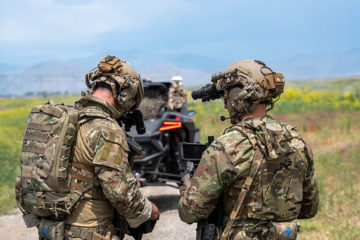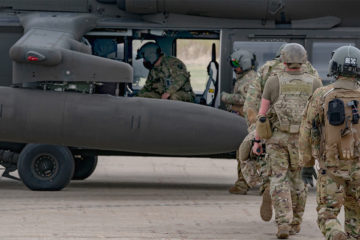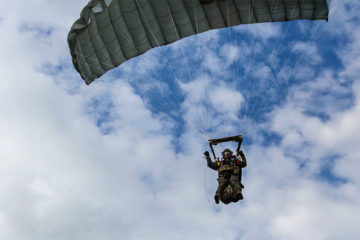Discussions at LANPAC Symposium highlight need for integrated, secure comms

Last month, the goTenna team had the opportunity to attend the Land Forces Pacific (LANPAC) Symposium, an annual event in Honolulu that connects military leaders, defense officials, and industry partners from across the Indo-Pacific region. More than just a conference, LANPAC is a strategic touchpoint—designed to align coalition land forces, strengthen regional partnerships, and address the operational realities of an increasingly contested and interconnected theater.
For companies like goTenna, LANPAC is a valuable opportunity to engage directly with operational end users, program leaders, and decision-makers to better understand the evolving mission requirements shaping land-based operations in the Indo-Pacific.
Discussions at this year’s symposium made it clear: while LANPAC is grounded in Army land force strategy, today’s operational realities demand seamless coordination across domains.
Effective communication is the backbone of that coordination—whether it’s sharing troop positions, syncing maneuver plans, or relaying intelligence, surveillance, and reconnaissance (ISR) data in real time. These constant exchanges are what build and sustain a common operating picture across joint and coalition forces.
This growing emphasis on multidomain coordination is driven by the rapid pace of technological advancement among near-peer adversaries, who are expanding their capabilities across every domain. To keep pace, the U.S. and its allies must be able to operate as an integrated force—linking land, air, maritime, space, and cyber assets in real time to respond to complex, contested threats.
But enabling that level of coordination across such a wide range of domains and mission sets is a growing challenge. Each domain operates on different platforms, timelines, and security protocols, creating real barriers to seamless communication. When you factor in joint service operations, coalition partners, and the contested terrain of the U.S. Indo-Pacific Command (USINDOPACOM) region, the challenge becomes even more complex.
The fight against signal superiority and airspace dominance
In modern conflict, communication isn’t just support—it’s a weapon. For today’s warfighters, the ability to relay information quickly, securely, and without detection can shape the outcome of an entire operation. But that advantage is increasingly under threat.
Electronic warfare (EW) has re-emerged as one of the most dangerous forces on the battlefield. Nowhere has this been more visible than in the current Ukraine conflict, where Russian forces have used advanced EW tactics to jam signals, geolocate troops, and exploit emissions from commercial devices—especially Bluetooth.
According to Hackers Arise, the EW systems being utilized in the Ukraine can currently, “…pick up more than 2,000 phones within a 3.7-mile range, potentially enabling a whole host of [military] positions to be found.” The threat is magnified when troops carry multiple devices—radios, personal phones, GPS trackers, and other wireless tools—all of which contribute to a larger electromagnetic signature that can be tracked or targeted.
Adding to the challenge, the airspace has become more contested than ever. After decades of operating without severe aerial threats, U.S. and allied forces now face adversaries equipped not only with modern air forces, but also with cheap, expendable drones that can strike within seconds of detection.
Unmanned aerial systems (UAS) and EW are increasingly intertwined on this new battlefield. As electronic signatures betray an operator’s location on the battlefield, low-cost, expendable UAS can be deployed to immediately put that operator under threat. As a volunteer operating on the front lines previously told The Last Mile, “Not only do the cell phone networks go down…[but] If your phone has just switched to a Russian network, it allows them to locate where you are…and they’re pretty good at figuring that out.”
THIS IS THE NEW REALITY FOR TACTICAL OPERATORS: A DRONE OVERHEAD, A JAMMER IN RANGE, AND TOO MANY SIGNALS IN THE AIR. EVERY PIECE OF GEAR–A PHONE, A RADIO, A TRACKER–ADDS ANOTHER LAYER OF VULNERABILITY…
Air defense—which was not as large of a priority when facing asymmetrical threats during the War on Terror—is once again a frontline priority, and it can’t operate in isolation. Like EW, air defense must be tightly integrated with base defense, expeditionary units, and coalition partners to be effective.
This is the new reality for tactical operators: a drone overhead, a jammer in range, and too many signals in the air. Every piece of gear—a phone, a radio, a tracker—adds another layer of vulnerability. In a battlespace where seconds matter, communications can make or break the mission.
Fortunately, there are integrated solutions available to help mitigate these threats.
The integrated mobile mesh advantage
In a battlespace where every signal can be seen, intercepted, or targeted, the way warfighters communicate must evolve. Mobile mesh networking solutions, such as goTenna, offer a fundamentally different approach—one designed for resilience, stealth, and flexibility in environments where traditional communications put lives at risk.
Unlike conventional systems that often broadcast loudly across the spectrum, mesh networks rely on low-power, short-burst transmissions that are inherently harder to detect or intercept. This capability aligns with two critical principles in contested environments: Low Probability of Detection (LPD) and Low Probability of Intercept (LPI).
MOBILE MESH ISN’T ABOUT REPLACING THE TRADITIONAL RADIO STACK, IT’S ABOUT INTRODUCING SMARTER, EMISSION-CONCIOUS TOOLS THAT STREGTHEN THE ENTIRE PACE PLAN…
By minimizing how often and how loudly devices transmit, mobile mesh helps reduce the digital footprint, making it far more difficult for adversaries to geolocate forces or trigger automated drone or counter-battery responses.
This quiet signature doesn’t come at the cost of connectivity. In fact, mobile mesh excels in degraded, GPS-denied, or infrastructure-limited conditions—where peer-to-peer relays keep teams connected off-grid. It also supports scalable coordination across joint and coalition forces. Paired with tools like Android Team Awareness Kit (ATAK), mobile mesh networks allow units from different services or partner nations to share position data and mission updates, all while staying below the noise floor of enemy surveillance.
As modern conflict continues to blur mission environments, communications must be just as adaptive. Mobile mesh isn’t about replacing the traditional radio stack, it’s about introducing smarter, emission-conscious tools that strengthen the entire PACE plan. In today’s signal-saturated battlespace like the Indo-Pacific region of LANPAC, it enables teams to communicate more effectively and securely without being seen.
To learn more about how mobile mesh networking can help the defense sector, click HERE.









No Comment